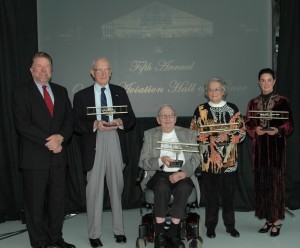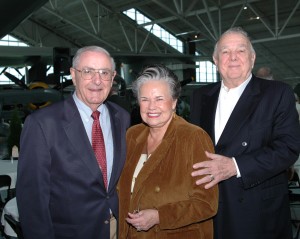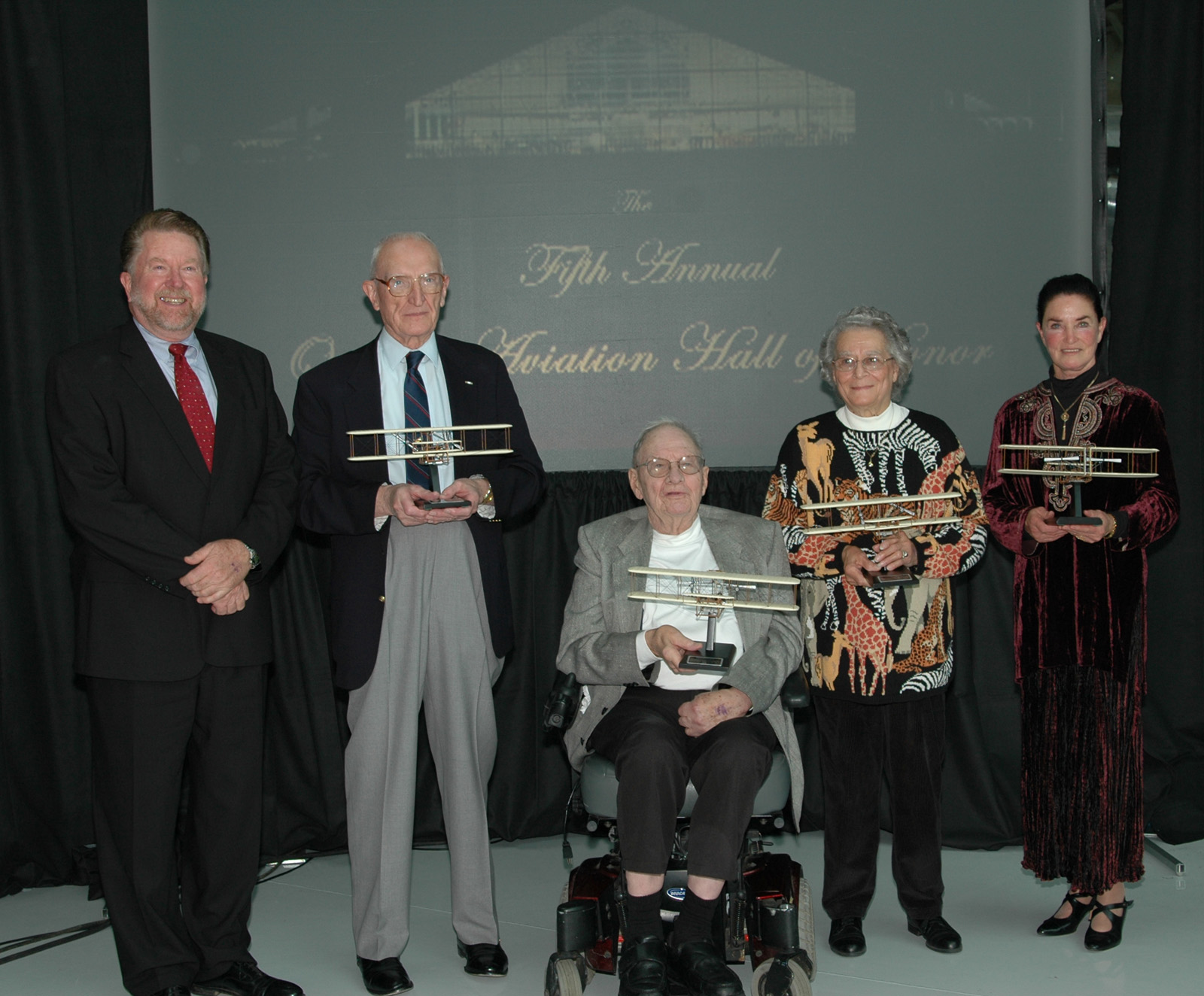
L to R: Mike Burrill poses with Brig. Gen. Staryl C. Austin Jr., Col. James Church, the wife of Col. Lawrence E. Campbell Jr. and the daughter of Nevilles E. “Jim” Walker. Wright Flyer trophies were presented to Oregon Aviation Hall of Honor recipients.
Five outstanding aviators were inducted into the Oregon Aviation Hall of Honor on Oct. 21, at the Evergreen Aviation & Space Museum in McMinnville, Ore. Gen. Staryl C. Austin Jr. and Col. James Church attended the ceremony. Col. Lawrence E. Campbell Jr., Maj. Gen. Chester E. McCarty and Nevilles E. “Jim” Walker were awarded posthumously.
Maj. Mike Allegre, Oregon Air National Guard, served as the event’s keynote speaker and the master of ceremonies was Mike Burrill Sr., chair of the Oregon State Board of Aviation.
Gen. Staryl C. Austin Jr.
A native Oregonian, Staryl C. Austin attended public schools in Bend, Albany and Salem, graduating from Salem High School in 1938. In September 1942, he enlisted in the Army Air Corps Civilian Pilot program. Since 1943, he served in many military leadership capacities in the Air Force and Air National Guard. As a first lieutenant, he flew in the European theater of operations. He completed 58 combat missions while flying the rugged P-47 Thunderbolt. His unit’s mission was air to ground support while destroying key German ground targets to pave the way for the Allies’ advance across France, Belgium and Germany.
In 1953, Austin joined the Oregon Air National Guard and eventually served as the 142nd Fighter Group’s air officer, chief of the administrative division and as assistant adjutant general until his retirement in December 1981. During his military service, he earned the Air Force’s Distinguished Service Medal, Legion of Merit, Air Medal with seven oak leaf clusters and the European-African-Middle East Campaign Medal with four battle stars.
Col. Lawrence E. Campbell Jr.
Lawrence E. Campbell became a resident of Oregon when his parents and siblings moved to Portland from Oklahoma in 1942 to work in the Kaiser Shipyards during WWII. He graduated from Washington High School and attended University of Portland.
He became the nation’s first African-American to fly a jet plane and to command an Air National Guard Unit. Campbell first started flying with the Civil Aeronautics Patrol in Portland while still in high school. He passed the Army Air Corps pilot exam in 1944 and was inducted in the pilot cadet training program at Tuskegee Army Air Force Base, training in the AT-6 aircraft. Following the end of WWII, he was amongst many cadets released from the service. He re-enlisted in 1946 and was sent to Randolph Field for advanced flight training in the P-47 Thunderbolt. Upon successful completion of this phase, Campbell was sent to Williams Field for his final training flying the P-51 Fighter aircraft.
Col. James Church

Evergreen International Aviation founder Delford Smith (right) and Maria Smith visit with former Governor Victor Atiyeh.
In 1968, after a distinguished 26-year career in the U.S. Air Force as an airfields engineer, Col. James Church retired and joined the Port of Portland. Over the next 18 years, he served as the director of engineering, planning and research, as well as the director of aviation, overseeing the operations of the Portland International, Hillsboro and Troutdale airports. Church developed an innovative financing and operating agreement between the Port of Portland and the airlines, which provided funding for both the day-to-day operations and the capital needs of its airports. His pioneering idea provided the airlines with input about airport operations and growth and supplied the Port of Portland with a steady source of funds to achieve its goals. Many airports across the country have emulated Church’s groundbreaking plan, which served as the vehicle for millions of dollars of capital and operating funds for Portland International Airport. When Church retired in 1984, an Oregon congressional delegation recognized him for distinguished service with the Port of Portland and the U.S. Air Force.
Maj. Gen. Chester E. McCarty
Chester E. McCarty was born in Pendleton, Ore., in 1905, and graduated from Northwestern College of Law in Portland in 1929. McCarty was active in the Oregon National Guard for many years, advancing from an infantry private to battery commander of artillery, holding all enlisted ranks through master sergeant. Assistant attorney general of Oregon from 1930 to 1936, McCarty was elected state senator in 1942, but declined to serve when he was called to active duty as an Army Air Corps captain that same year.
During WWII, he served as squadron commander, operations officer, staff officer with the North Africa Wing of the Air Transport Command and later, commander of a chain of air bases in the Middle East. After WWII, he became active in the Air Force Reserve as commander of the 305th Air Division and later of the 403rd Troop Carrier Wing.
From 1949-1950, he served as the national president of the Air Reserve Association and in 1951, he was recalled to active duty and flew combat airlift missions in Korea. He assumed command of many air divisions over the years, including the 315th Air Command, the Tactical Air Command’s 18th Air Force and the 14th Flying Tiger Air Force at Robbins Air Force Base. McCarty flew almost every type of Air Force aircraft, including the supersonic F-100 and F-104 jet fighters and piloted many types of airline’s jet aircraft.
Nevilles E. “Jim” Walker
Nevilles E. “Jim” Walker’s pioneering and innovative production of ready-to-fly models set a precedent for those who followed, shaping the future of the hobby world. Walker’s company, American Junior Aircraft, turned out over 232 million models during its existence. By 1958, Walker possessed 31 patents for his inventions. By the time of his death that same year, his compassion for flying had inspired thousands.
He constantly gave away models to children as a means of encouragement for having fun and learning about flight. His four principals for success convey this clearly: designing and engineering aerodynamic airplane models; creating models with precision, ensuring their capability to fly successfully; creating models quick and easy to assemble; and pricing them so the average child could afford their purchase.











